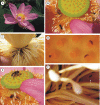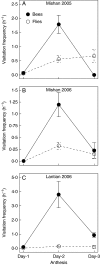Effective pollinators of Asian sacred lotus (Nelumbo nucifera): contemporary pollinators may not reflect the historical pollination syndrome
- PMID: 19617594
- PMCID: PMC2749538
- DOI: 10.1093/aob/mcp173
Effective pollinators of Asian sacred lotus (Nelumbo nucifera): contemporary pollinators may not reflect the historical pollination syndrome
Abstract
Background and aims: If stabilizing selection by pollinators is a prerequisite for pollinator-mediated floral evolution, spatiotemporal variation in the pollinator assemblage may confuse the plant-pollinator interaction in a given species. Here, effective pollinators in a living fossil plant Nelumbo nucifera (Nelumbonaceae) were examined to test whether beetles are major pollinators as predicted by its pollination syndrome.
Methods: Pollinators of N. nucifera were investigated in 11 wild populations and one cultivated population, and pollination experiments were conducted to examine the pollinating role of two major pollinators (bees and beetles) in three populations.
Key results: Lotus flowers are protogynous, bowl shaped and without nectar. The fragrant flowers can be self-heating during anthesis and produce around 1 million pollen grains per flower. It was found that bees and flies were the most frequent flower visitors in wild populations, contributing on average 87.9 and 49.4 % of seed set in Mishan and Lantian, respectively. Beetles were only found in one wild population and in the cultivated population, but the pollinator exclusion experiments showed that beetles were effective pollinators of Asian sacred lotus.
Conclusions: This study indicated that in their pollinating role, beetles, probable pollinators for this thermoregulating plant, had been replaced by some generalist insects in the wild. This finding implies that contemporary pollinators may not reflect the pollination syndrome.
Figures




Similar articles
-
Ecological relationship between floral thermogenesis and pollination in Nelumbo lutea (Nelumbonaceae).Am J Bot. 2014 Feb;101(2):357-64. doi: 10.3732/ajb.1300370. Epub 2014 Jan 23. Am J Bot. 2014. PMID: 24458119
-
Flower thermoregulation facilitates fertilization in Asian sacred lotus.Ann Bot. 2009 May;103(7):1159-63. doi: 10.1093/aob/mcp051. Epub 2009 Mar 12. Ann Bot. 2009. PMID: 19282320 Free PMC article.
-
Pollinator specialization and pollination syndromes of three related North American Silene.Ecology. 2009 Aug;90(8):2077-87. doi: 10.1890/08-1141.1. Ecology. 2009. PMID: 19739370
-
[The many ways flowers send signals to pollinators].Biol Aujourdhui. 2024;218(3-4):129-140. doi: 10.1051/jbio/2024013. Epub 2025 Jan 27. Biol Aujourdhui. 2024. PMID: 39868712 Review. French.
-
Mechanisms and evolution of deceptive pollination in orchids.Biol Rev Camb Philos Soc. 2006 May;81(2):219-35. doi: 10.1017/S1464793105006986. Biol Rev Camb Philos Soc. 2006. PMID: 16677433 Review.
Cited by
-
Unidirectional hybridization and reproductive barriers between two heterostylous primrose species in north-west Yunnan, China.Ann Bot. 2014 Apr;113(5):763-75. doi: 10.1093/aob/mct312. Epub 2014 Feb 2. Ann Bot. 2014. PMID: 24492637 Free PMC article.
-
Occurrence and Prevention of Delayed Autonomous Selfing in Salvia umbratica (Lamiaceae).Front Plant Sci. 2021 Jul 26;12:635310. doi: 10.3389/fpls.2021.635310. eCollection 2021. Front Plant Sci. 2021. PMID: 34381465 Free PMC article.
-
Loss of pollinator diversity consistently reduces reproductive success for wild and cultivated plants.Nat Ecol Evol. 2025 Feb;9(2):296-313. doi: 10.1038/s41559-024-02595-2. Epub 2024 Dec 11. Nat Ecol Evol. 2025. PMID: 39663417
-
Urbanization threaten the pollination of Gentiana dahurica.Sci Rep. 2019 Jan 24;9(1):583. doi: 10.1038/s41598-018-36773-7. Sci Rep. 2019. PMID: 30679533 Free PMC article.
-
A question of data quality-Testing pollination syndromes in Balsaminaceae.PLoS One. 2017 Oct 16;12(10):e0186125. doi: 10.1371/journal.pone.0186125. eCollection 2017. PLoS One. 2017. PMID: 29036172 Free PMC article.
References
-
- Baker HG, Hurd PD. Intrafloral ecology. Annual Review of Entomology. 1968;13:385–414.
-
- Bernhardt P. Convergent evolution and adaptive radiation of beetle-pollinated angiosperms. Plant Systematics and Evolution. 2000;222:293–320.
-
- Borsch T, Barthlott W. Classification and distribution of the genus Nelumbo Adans. (Nelumbonaceae) Beiträge zur Biologie der Pflanzen. 1994;68:421–450.
-
- Castellanos MC, Wilson P, Thomson JD. Pollen transfer by hummingbirds and bumblebees, and the divergence of pollination modes in Penstemon. Evolution. 2003;57:2742–2752. - PubMed
-
- Crepet WL. The role of insect pollination in the evolution of the angiosperms. In: Real L, editor. Pollination biology. Orlando, FL: Academic Press; 1983. pp. 25–50.

